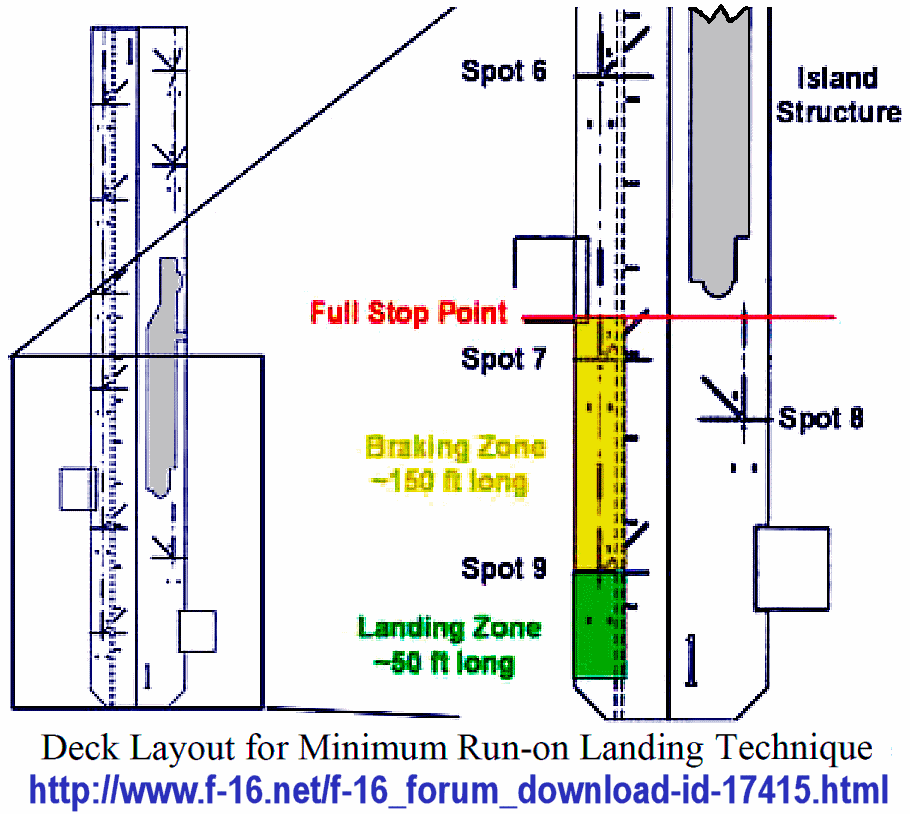'Not_a_boffin' thanks for the scary 'Edward Scissorhands' V-22 photo. At the risk of boring youse all - these text extracts and graphics are from the post here:
http://www.pprune.org/military-aircr...ml#post7792460
MV-22B OSPREY SHORT TAKEOFF AND MINIMUM RUN-ON LANDING TESTS ABOARD LHD CLASS SHIPS 26 Feb 2009
Virginia T. Mitchell & William P. Geyer V-22 Ship Suitability Engineers
Naval Air Warfare Center Aircraft Division Patuxent River, Maryland
http://www.f-16.net/f-16_forum_download-id-17415.html (1.1Mb)
http://www.vtol.org/f65_bestPapers/t...Evaluation.pdf (original download not working)
"
ABSTRACT
...The V-22 also demonstrated that
MROLs are a new and safe technique for landing on LHD 1 class ships at an appreciable ground speed across the spectrum of GWs [Gross Weights] bands...."
&
"...The MROL technique involved the aircraft performing a stern approach to the ship targeting touchdown on spot 9, rolling along the longitudinal “crow’s foot” lineup lines, and fully stopping just prior to the aft end of the island. The touchdown and braking zone is shown in Figure 16. Prior to sea trials, stopping distances were predicted for 15 to 20 kt ground speeds based on STOLCOMP which was validated by landbased test data. Based on these predictions, there was sufficient deck space available to stop the aircraft from a 20 kt Touchdown Speed Relative to the Ship (TSRTS). TSRTS is defined as the difference between aircraft ground speed and ship ground speed.
The MROL procedures develop as follows:
• Turn base at 2 nautical miles and 800 feet and begin to slow to 60 nacelle/120 kt indicated airspeed
• Landing checks complete
• Turn final and
slow to 50-60 kt indicated air speed at 83-85 deg nacelle [see photo]
• Intercept glideslope at 1.1 nautical miles
• Maintain a 7 deg glideslope and establish recommended airspeed
• Confirm WOD and Ship’s speed over ground to determine landing touchdown speed
• At 0.2 nautical miles rotate nacelles aft 2-3 deg, use longitudinal stick as required to capture touchdown speed
• Prior to crossing the deck edge, transition from indicated airspeed to groundspeed. Target aircraft ground speed was ship’s ground speed plus TSRTS as determined from touchdown predictability tests
• Target spot 9 mainmount markings for touchdown
• Maintain 0-5 deg nose up until MLG touchdown
• Reduce TCL to aft stop at touchdown
• Smoothly lower nose wheel to ground
• Apply hard braking
• Adjust nacelle angle to full aft at maximum rate
• Select nose wheel steering when the gear is firmly on the ground if desired
• Terminate maneuver by adjusting nacelles forward to prevent aircraft from rolling aft...
&
...The landing airspeed was limited to
no less than 30 kt based on simulation results. The difference in aircraft and ship ground speed was mathematically equivalent to the difference in aircraft and ship wind speed....
&
...
MROL Envelope Expansion
A total of 11 MROLs were conducted completing 6 of the 52 planned MROL test points with required repeats. Due to limited test time at sea, only MROL touchdown predictability and GW expansion tests were conducted....
...
Performance
MROL testing began with touchdown predictability to determine the pilot’s ability to touchdown within the touchdown zone and determine what the appropriate touchdown speed relative to the ship (TSRTS) would be to safely stop within the braking zone. Figure 26 presents stopping distance as a function of TSRTS for both touchdown predictability tests as well as GW expansion. Note that touchdown predictability test points for TSRTS from 12 to 15 kt [not below 30 KIAS] resulted in stopping distances from 89 to 121 feet.... Test results demonstrated that MROL ground roll distances with TSRTS up to 22 kt could be achieved with the flight deck space available aft of the island. The touchdown positions relative to the target touchdown point are presented in Figure 27. Aside from the one outlier, pilots were able to accurately land the aircraft within the touchdown zone....
...The general pilot sentiment was that
MROLs were a benign maneuver for the GWs tested. In addition, the pilots commented that maintaining ground speed relative to the ship during a MROL actually created an easier approach than attempting to decelerate to a hover, reducing lateral workload as the aircraft crossed the deck edge.
The MROL technique was validated in the shipboard environment....
...
CONCLUDING REMARKS
...MROL demonstrated to be a revolutionary and safe way to land aboard ship at GWs heavier than VTOL capability and will continue to be developed and tested. An MROL envelope was not recommended due to insufficient test data; however when more can be gathered, the possibility of granting an envelope to the fleet exists...."

